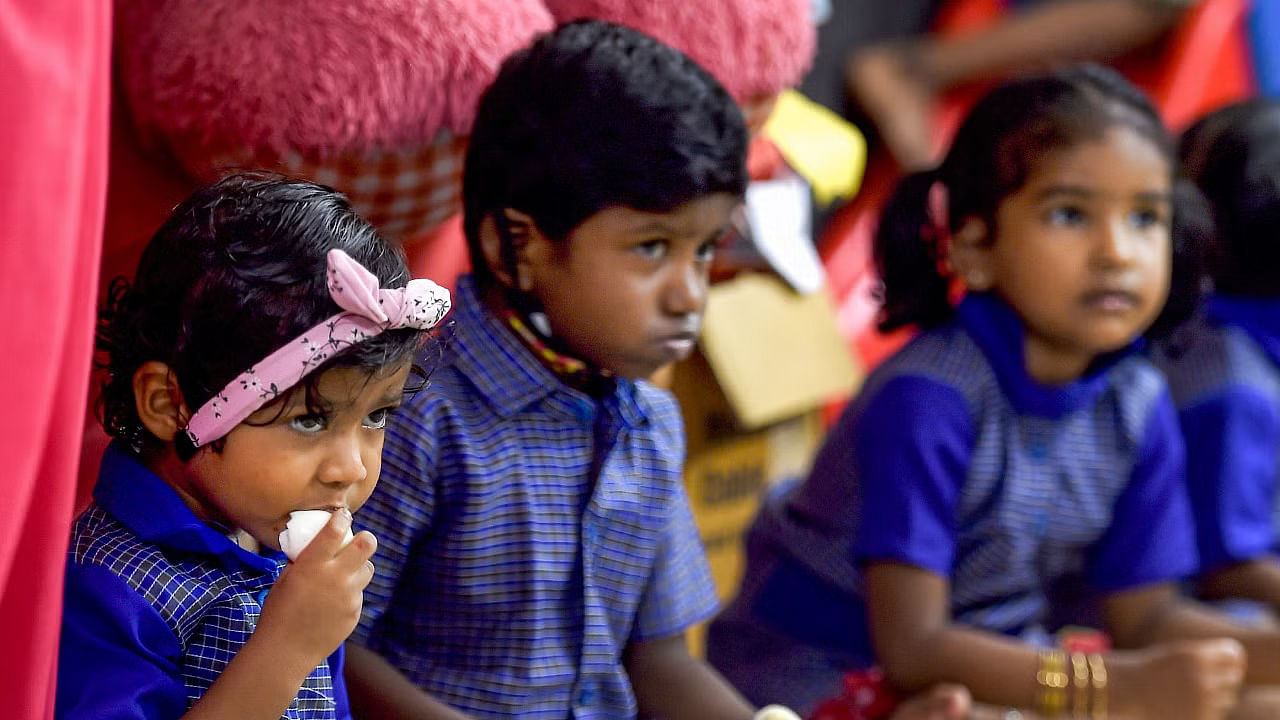
Representative image of children.
Credit: PTI Photo
India has made remarkable strides in various sectors, including space, since gaining independence. However, one critical aspect that continues to be overlooked is the holistic development of its children. India’s historical preoccupation with child survival rates, nutrition, and vaccination, while essential, has sometimes overshadowed the need for early intervention in child development.
The Integrated Child Development Services (ICDS) programme, initiated to address child malnutrition and health concerns, has primarily focused on food and nutrition–a remnant of the trauma of staggering infant mortality rates in the newly Independent India. While this is undoubtedly vital, it falls short of addressing the holistic needs of children who have survived infancy.
The ICDS has 6 pillars for child survival: care during pregnancy, safe child birth, immunization, nutrition, safety, and holistic child development. But its monitoring chart has only two parameters–height and weight, and the focus is mainly on physical development, to the near exclusion of cognitive, social and emotional development of children. Prevention of childhood disabilities also requires early identification and intervention in the 0-2 year period or the first 1000 days of life. Development interventions, even globally accepted ones such as CBR-Portage, and Montessori education, are completely absent in the ICDS mandate and must be included.
When it does focus on early education, the ICDS primarily emphasises the “3Rs” - Reading, wRiting, and aRithmetic - but neglects crucial aspects of holistic child development.
Furthermore, developmental parameters are conspicuously absent from the ICDS checklist. Instead, India adopts international scales, which may not fully cater to the diverse needs of its children. Kerala is one of the few states that have developed specific developmental parameters, but these may not be applicable to other regions, such as tribal areas in the northeast, Madhya Pradesh, Rajasthan, and Orissa, highlighting the need for a more inclusive approach.
The first six years of a child’s life are considered the foundation for future development and success. Unfortunately, this critical period is somewhat orphaned within the Indian administrative framework. The health department typically doesn’t take on the responsibility, the women and child welfare department is inadequately equipped, and the education ministry isn’t held accountable for early childhood development. Formal education starts at 6 years of age. While NEP 2020 prioritises early childhood education to provide quality learning to children aged 3-6, and India formulated its Early Childhood Care and Education (ECCE) policy in 2013, ground realities do not support this ambition.
Although there are several lakh preschools in India, the majority do not follow a systematic curriculum for holistic child development and they are not bound by any formal frameworks to deliver qualitative and/or quantitative learning outcomes. This lack of accountability can lead to suboptimal learning outcomes and hinder a child’s potential.
Internationally recognized models such as Portage, developed in 132 countries, is available as a package in 9 languages, Piaget’s theory of child development, and Montessori’s educational approach, offer valuable insights into early childhood development. However, it is essential to adapt these global concepts to suit India’s unique cultural, linguistic, and socio-economic diversity.
While mandatory education in India is from ages 6 to 18, research shows that the most critical period for development is from 0 to 6 years. Therefore, early intervention during this time can significantly impact a child’s future learning outcomes, making it imperative to invest in these formative years.
There are over a lakh pre-schools in Karnataka alone. Isn’t that enough for early education? Yes, if the teachers were trained with a standardised curriculum that resulted in meaningful, measurable outcomes.
Currently, there are no recognised, standardised training modules in Karnataka that prepare teachers specifically for early childhood education barring a diploma in early childhood care and inclusive education conducted by Karnataka State Open University in collaboration with CBR Network and Indian institute of Montessori Studies. While more such courses are needed, with increased visibility and state support, to encourage preschool teachers to equip themselves better, the lone KSOU course, too, will also remain under the constant threat of closure without adequate support.
One viable solution is to invest in training Anganwadi workers, who play a crucial role in child development at the grassroots level. The government should allocate funds for their training and consider increasing their remuneration post-training to incentivise professional growth and commitment. This need for additional investment perhaps is one of the factors that is holding back governments from taking concrete steps to strengthen early childhood education.
Private preschools can also contribute to early intervention efforts. While financial incentives may not be their primary concern, they seek recognition from the government and a degree of accountability to ensure quality education. Untrained teachers in preschools can inadvertently hinder a child’s development, affecting their ability to learn in the long-run, hence the need for professionalisation.
Early intervention in child development is like the ‘Amrith Galige’ or the golden period for nurturing future leaders and responsible citizens of India, according to Dr Indumathi Rao, director of Community-Based Rehabilitation Network in India. As the country continues to progress, it is crucial to shift the focus from survival to holistic development in the early years of a child’s life. By recognising the importance of early intervention, adapting global models to local needs, and investing in the training of key personnel, India can pave the way for a brighter future for its children, ensuring that no child is left behind in the journey of holistic development.